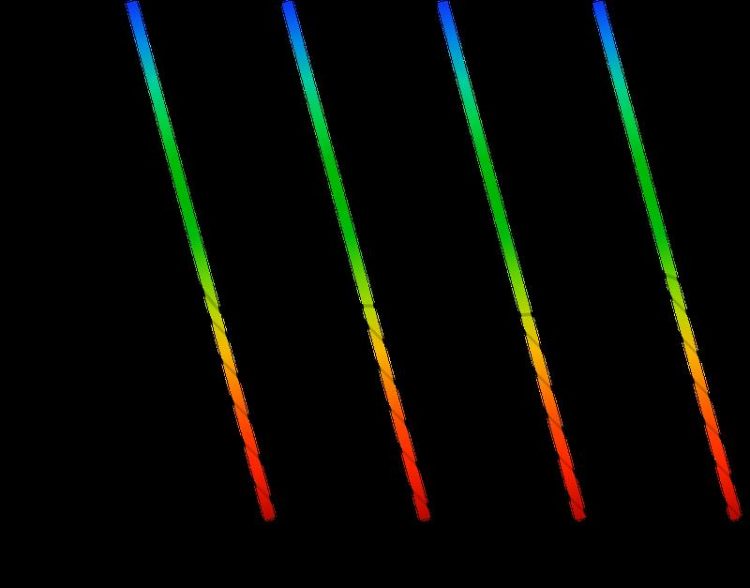High-speed 3D surface measurement using confocal laser scanning microscopy

In the invention, the focal lengths related to the different wavelengths of light - shown in the picture with the respective color - are directed obliquely onto the object surface. Images: Luo, KIT
A new method provides a 3-dimensional image using confocal laser scanning microscopy (CLSM). This novel approach allows for much faster measurements.
Optical surface measurement methods used for the characterization of micro/nano structures are very well suited for the evaluation of surfaces. These measurement methods are therefore preferably used for non-contact optical measurements in automated test procedures or in the field of quality assurance.
Scientists from the Institute of Interactive Real-Time Systems at the Karlsruhe Institute of Technology (KIT) now succeeded in developing a new method that provides a 3-dimensional image using confocal laser scanning microscopy (CLSM).
This novel approach allows for much faster measurements. Compared to conventional measuring systems, the scanning speed is increased by a factor of several hundred with only a slight impact on the resolution.
Conventional confocal microscopes obtain 3D images by successively scanning individual sample points and then assimilating the detected signals.
Splitting the light into different colors provides a z-stack, i.e. depth data for the 3D image. The two prevailing methods for increasing the scan rates are slit scanning microscopy and programmable array microscopy.
Both methods reduce the scanning frequency by passing the beam over the focal plane in one direction only. Slit scanning microscopes use a slit illumination source to scan the sample repeatedly in a bar or line and capture the signals through a slit aperture.
Programmable array microscopes, by contrast, use MEMS (micro-electro-mechanical systems) technology to illuminate the object through an array of pinholes that produce illuminated points on the sample surface. This array is used to scan the object in order to collect the data required for imaging.
Instead of additional scanning in the z-direction (axial direction), both technologies can be complemented by chromatic confocal microscopy, taking advantage of the fact that light of different wavelengths has different focal planes along the z-axis to determine object height. Unfortunately, mechanical scanning, which is only one-dimensional, adversely affects the speed of the 3D imaging process in both cases.
The invention developed by Dr. Ding Luo, KIT, enables area scanning by combining the advantages of chromatic confocal microscopy and a new method for 2D surface scanning.
Based on a modified confocal microscope setup, it is possible to scan the surface, whereby the scanning speed is several hundred times faster. The axial uncertainty is increased by a factor of about 2.5, which means that the resolution is only slightly reduced.
A prototype and numerical calculations are available to demonstrate the advantages compared to the state of the art. Since the effect can be simulated, it is possible to calculate the benefits for different microscopy systems.
A patent application for this invention has been filed in Germany and in the United States. On behalf of the Baden-Württemberg Foundation, Technologie-Lizenz-Büro (TLB) GmbH supports the KIT in patenting and marketing its innovation. TLB has been commissioned with the global business implementation of this pioneering technology and offers companies possibilities to cooperate and license the patents.
For more detailed information, please contact Dr.-Ing. Florian Schwabe, Innovation Manager, at schwabe@tlb.de.
Media Contact
All latest news from the category: Physics and Astronomy
This area deals with the fundamental laws and building blocks of nature and how they interact, the properties and the behavior of matter, and research into space and time and their structures.
innovations-report provides in-depth reports and articles on subjects such as astrophysics, laser technologies, nuclear, quantum, particle and solid-state physics, nanotechnologies, planetary research and findings (Mars, Venus) and developments related to the Hubble Telescope.
Newest articles

NASA: Mystery of life’s handedness deepens
The mystery of why life uses molecules with specific orientations has deepened with a NASA-funded discovery that RNA — a key molecule thought to have potentially held the instructions for…

What are the effects of historic lithium mining on water quality?
Study reveals low levels of common contaminants but high levels of other elements in waters associated with an abandoned lithium mine. Lithium ore and mining waste from a historic lithium…

Quantum-inspired design boosts efficiency of heat-to-electricity conversion
Rice engineers take unconventional route to improving thermophotovoltaic systems. Researchers at Rice University have found a new way to improve a key element of thermophotovoltaic (TPV) systems, which convert heat…



